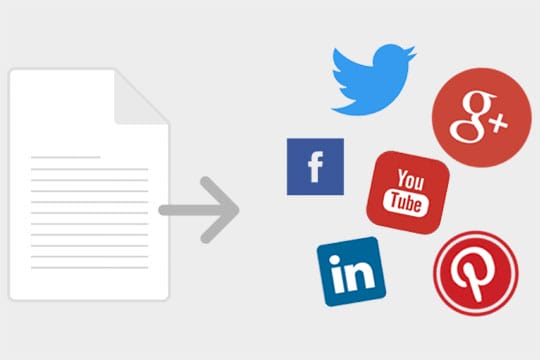There are well over three billion active users on social media. Therefore, a digital presence is essential for your brand to attract and retain customers. Your company understands the importance of creating unique and compelling content on social media. But, are there some topics that will get your brand the wrong kind of attention?
In this article, we will discuss the importance of social media as a tool to build and maintain your brand image. We’ll also list the 6 types of content to avoid when engaging your social media followers.
How can social media serve as a branding tool?

Social media is key to successfully building your brand. Having a presence on social media displays your company to a wide audience. Although having good viewership sounds great, it also raises the stakes. One small slip-up, especially in the early stages, can destroy your brand’s image for life.
It’s essential to understand the dos and don’ts of branding when it comes to social media content. Creating content that is true to your brand’s image, incorporating colors that reflect your official logo, and providing value to your reader is integral. Just as important is understanding what to avoid when you’re on the quest to continually provide engaging and relevant content.
Recommended for you: Social Media Marketing Solutions Driving Towards $41.6B Led by Video.
Avoid these types of content on social media

Here are the kinds of content that you should avoid posting on a business or corporate social media account:
1. Steer clear of sensationalism

Attention-grabbing headlines are ideal, but going over the top can prove to be one of the biggest mistakes you can make when writing your social media posts. In 2020, most internet users are familiar with the word “clickbait” and sensational headlines raise a red flag immediately.
Over-the-top headlines are old-fashioned and simply don’t work anymore. In fact, Facebook, among other platforms, has banned sensational headlines and clickbait. Facebook determines which links are likely to be misleading by the length of time users spend on the link after clicking on it. The less time people spend on the site connected to the link, the more likely it contain little valuable information or context related to the original headline.
A popular Twitter handle, @savedyouaclick pokes fun at phony marketing headlines by reposting links while summarizing the entirety of the article in one sentence. In one post, they feature a link with the headline “You Won’t Believe What Instantly Kills Coronavirus!” with the answer within the link: hand sanitizer.
Although it’s tempting to tout your product or service as the best solution to a pressing problem, you might want to reconsider your headline and make sure it is truly an accurate representation of what your content contains.
2. Be careful of being too unscripted

Brands should build organic relationships with their followers in a natural way, right? Using features like Facebook Live to quickly create content can build people’s connection with your brand and boost your likeability factor. The feeling of being “at the moment” can prove invaluable to driving engagement and converting sales.
Be wary of becoming too unscripted, though. Like a good reality show, everything has to follow some sort of guideline or it goes off the rails. An important influencer marketing tip is to avoid rambling, irrelevant live video chats.
Your company should also be careful about who they allow having a live platform. As coronavirus-era Zoom meeting screenshots have shown us, oftentimes hilariously embarrassing things can happen while streaming live. A slip-up like this could be a boon for your brand or a major obstacle depending on the circumstances.
For example, the entertainment website HMV received some very bad press on its Twitter account after laying off several employees. Evidently, one of those laid-off employees was in charge of the Twitter account. “There are over 60 of us being fired at once! Mass execution of loyal employees who love the brand!” read one of the Tweets after that ill-fated day. Another one: “Just overheard our Marketing Director (he’s staying, folks!) ask ‘How do I shut down Twitter?’ “ Case in point: be careful how freely you allow employees to post on your social media.
A similar scenario unfolded at the Monterey Bay Aquarium when an employee took it upon herself to post a photo of a sea otter. The employee used words to jokingly describe the otter’s curviness which later caused a large amount of backlash from the African-American community. Some resented the appropriation of words derived from the African American vernacular by a non-Black employee to describe an animal at the zoo.

3. Stop the negativity

Don’t criticize your competitors – negativity and bitterness don’t play well on social media. The fast-food chain Wendy’s is a notable exception, due to its tongue-in-cheek skills and coyness. It’s difficult to pull out a clap back on social media without seeming petty.
Avoid the temptation of responding to your critics and negative press. You’re just giving that negativity more of a platform. You can also utilize social media analytical tools that will analyze metrics such as keywords and influencer management to determine what content customers are more interested in knowing more about your brand. Social media analytics is used to measure the ROI of an organization’s social media channels, so you can better understand the impact of each campaign on your overall marketing efforts.
While negativity has been shown to garner lots of attention – the word “trolling” was invented just to describe it – this kind of attention does not help serious businesses convert sales. James Charles, the first male Cover Girl, and famous YouTuber found himself in the crosshairs of what has now been termed “Dramageddon” following an extremely negative video posted by his former mentor, Tati Westbrook.
In the video, Westbrook accused Charles of everything from unprofessional to inappropriate behavior. As a result, Charles lost hundreds of thousands of followers within a few days. Years later, Westbrook posted another video apologizing to Charles and stating that her claims were false and the result of malicious gossip. Needless to say, although both beauty YouTubers gained a lot of attention from what some believe to be a publicity stunt, the credibility (and sales) of both brands’ beauty supplies have gone down.
You may like: Interesting Ways to Thank Your Customers on Social Media.
4. Give thought before lip service to divisive political issues

The Black Lives Matter movement was accompanied by a frenzy of social media activity as numerous major companies rushed to voice their support for the movement. However, some of the longtime supporters of BLM pointed out that many of their statements and hashtags were clearly merely performative.
If your company does want to take a stance about an important issue, it’s vital to be serious about it. Nike was one of the first companies to voice support for BLM before it was the common trend, and even adapted their slogan for the movement.
If your brand wants to join a currently popular political movement on social media, it’s important to think deeply about it and avoid empty gestures. As always when you take a stand on an issue, prepare for a new wave of fans as well as the inevitable backlash.
Goya is a brand that knows all too well about this. Their CEO, Robert Unanue, caused controversy by not only openly supporting president Trump but claiming the country was “truly blessed” to have him as a leader. As a result, a huge backlash and organized boycott emerged against the Goya brand by those on the other side of the political spectrum. Unanue tried to walk back his comments claiming these were his personal beliefs and did not reflect that of the company, but the damage was done.
And then yet another reaction unfolded – a Goya “buycott” was promoted by none other than Ivanka Trump herself urging supporters to buy Goya products. Which side was more successful? It remains unclear – although Goya bean sales went up by more than 400%, this was during the height of the pandemic and at a time when American households were stocking up on canned goods anyway.

5. Avoid inconsistently branded content

Most companies employ a social media manager to avoid this scenario: a totally inconsistent tone when posting on social media. To build rapport and trust with your customers, it’s important that your content flows well. Disjointed social media content makes your brand seem less personal.
For example, there could be a post from one writer who enjoys the use of Emojis next to an article from another writer who comes off as overly formal. You’ve just made your brand seem unreliable and disorganized right off the bat.
One of the best ways to ensure that content will remain consistent is to take the time to write and edit several posts ahead of time. Most good marketing automation services or software (e.g. FreshBooks Time Tracking) will allow you to track the time each team member spends on work (in this case writing the posts ahead of time) and then post scheduled content across social media channels. This will both help to save your marketing team time and help ensure that the content and tone of each post remain consistent with your brand.
That’s not to say your social media content strategy wouldn’t benefit from guest blogging. Allowing diverse voices to have a platform is a big “do” in 2020: however, it’s important to keep the writing style and content in sync with your brand’s overall image.
Also always be aware of your customer demographics. Young users might enjoy interesting content on a platform like TikTok. A more universal platform like Facebook might be the better choice if your brand is trying to market to seniors.
6. Be careful about revealing confidential information

People reveal a lot about themselves on social media, whether they realize it or not. We’re at the point now where it’s possible to know intimate details about people such as their addresses, friends and family members, certain financial details, location of tattoos, the color of their houses, and the types of vehicle they drive just by what they post on social media.
It’s specifically for this reason that there have been major reforms in regards to privacy online and on social media in recent years. It’s also why people have been growing increasingly concerned about the privacy of their personal lives, to the point that even insurance companies will often base their premiums on what they find on an applicant’s social media account. For example, a person who posts photos of themselves jogging will likely get a better life insurance premium and rate than someone who posts photos of themselves smoking.
With that in mind, sometimes you can reveal too much about your company without even realizing it. Last year, HP’s vice president “inadvertently tipped off competitors” after mentioning details about the company’s cloud services on his LinkedIn profile. This indiscretion cost HP its competitive edge and reduced stock value, affecting thousands of people.
Additionally, this is also why it’s of the utmost importance to take action to secure your company’s own social media profiles and content as well. Require two-factor authentication to log in to your business social media accounts, always utilize a virtual private network (VPN) that comes with robust end-to-end encryption when connected to your company’s network to ensure that your accounts cannot be broken into by hackers, and create a company email account used exclusively for social media management (this way if the social media accounts are compromised, the hackers won’t be able to access any other data).
You may also like: Top 10 Best Free Social Media Marketing Tools for Startups.
Conclusion

Consistently creating engaging content is a must for building your brand. However, that doesn’t mean that the content you create doesn’t have to add valuable information for your followers.
Keep your followers and your brand image intact by avoiding sensational headlines, empty political statements, negativity, aggressive sales tactics, and stolen material. It’s also important to be wary of accidentally revealing confidential information about your company and clients by oversharing, creating content that is inconsistent with your brand, and being mindful of how you stream live.





